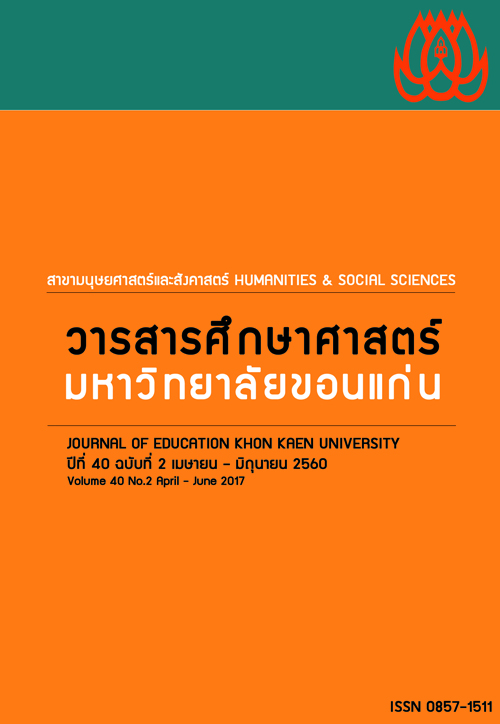ชุมชนแห่งการเรียนรู้ทางวิชาชีพเพื่อการพัฒนาเด็กปฐมวัยยุคใหม่ : การศึกษาเฉพาะกรณี Peace Paragon สวนประชุมเจ้าชายตัวน้อยบ้านสวนเล็กแห่งความรัก
Main Article Content
บทคัดย่อ
บทคัดย่อ
การวิจัยครั้งนี้ มีวัตถุประสงค์เพื่อศึกษาลักษณะความเป็นชุมชนแห่งการเรียนรู้ทางวิชาชีพเพื่อการพัฒนาเด็กปฐมวัยยุคใหม่ กรณีศึกษา Peace Paragon สวนประชุมเจ้าชายตัวน้อยฯ ผู้วิจัยได้เลือกผู้ให้ข้อมูลหลัก (Key Informants) แบบเฉพาะเจาะจง (Purposive Sampling) ซึ่งเป็นครูอาสาที่มาจัดกิจกรรมพัฒนาเด็กปฐมวัยที่ Peace Paragon สวนประชุมเจ้าชายตัวน้อยฯ อย่างน้อย 1 ปีขึ้นไปรวม 7 คนประกอบด้วย ครูอาสาจากโรงเรียนของรัฐ 2 คน ครูอาสาจากโรงเรียนเอกชน2 คนและครูอาสาจากสาขาอาชีพอื่นๆ 3 คนเครื่องมือที่ใช้ในการเก็บข้อมูลเป็นแบบสัมภาษณ์แบบกึ่งโครงสร้าง การวิเคราะห์ข้อมูลใช้สถิติ ความถี่ และร้อยละ ในการวิเคราะห์ข้อมูลทั่วไปของผู้ให้ข้อมูลหลัก การวิเคราะห์ข้อมูลเชิงคุณภาพจากประเด็นการสัมภาษณ์ใช้วิธีการวิเคราะห์โดยการจำแนกชนิดข้อมูล (Typological Analysis) แล้วแจงนับความถี่และร้อยละ เพื่อสร้างข้อสรุปแบบอุปนัย (Analytic Induction) จากนั้นนำผลที่ได้มาอภิปรายร่วมกับแนวคิดและวรรณกรรมที่เกี่ยวข้องเพื่อสรุปผลการวิจัย
ผลการวิจัยพบว่า
1. บริบทของชุมชนแห่งการเรียนรู้ทางวิชาชีพ Peace Paragon สวนประชุมเจ้าชายตัวน้อยฯ มีลักษะดังนี้ 1) เหตุผลของการรวมตัวกันของครูอาสาฯ คือ ต้องการนำความรู้มาเติมเต็ม ใช้เวลาว่างทำประโยชน์แก่ส่วนรวม และชอบแนวคิดของผู้ริเริ่มโครงการ 2) ความโดดเด่นเฉพาะของชุมชนแห่งการเรียนรู้ทางวิชาชีพ Peace Paragon สวนประชุมเจ้าชายตัวน้อยฯ คือ เปิดโอกาสให้ผู้คนที่หลากหลายและแตกต่างเข้ามาเรียนรู้การให้ และพัฒนาเด็กด้วยกิจกรรมภาษาอังกฤษ ศิลปะ และเล่านิทานคุณธรรม 3)ประโยชน์ของการพัฒนาเด็กปฐมวัยตามรูปแบบชุมชนแห่งการเรียนรู้ทางวิชาชีพ Peace Paragon สวนประชุมเจ้าชายตัวน้อยฯคือ มีพื้นที่พบปะกัน ของครู เด็กปฐมวัย และสถาบันครอบครัวเพื่อทำกิจกรรมที่สร้างสรรค์ร่วมกัน สร้างผู้มีจิตอาสา ช่วยอนุรักษ์ธรรมชาติและวัฒนธรรมประเพณีอันดีงาม
2. ความเป็นชุมชนแห่งการเรียนรู้ทางวิชาชีพของ Peace Paragon สวนประชุมเจ้าชายตัวน้อยฯ มี 6 องค์ประกอบ ได้แก่ 1) การมีวิสัยทัศน์ร่วมทุกคนมองเห็นภาพอนาคตร่วมกัน และช่วยกันสร้างนวัตกรรมขึ้นมาเพื่อพัฒนาเด็กปฐมวัย จนเกิดเป็นชุมชนแห่งการเรียนรู้ของครูอาสา 2) ทีมร่วมแรงร่วมใจ มีการทำงานเป็นทีมด้วยความเต็มใจ เต็มศักยภาพและความสามารถ มีความสามัคคีเป็นหนึ่งเดียว 3) ภาวะผู้นำร่วม ทุกคนได้มีส่วนริเริ่ม ร่วมคิด ร่วมตัดสินใจอย่างมีอิสรภาพ ร่วมขับเคลื่อนภารกิจไปสู่ความสำเร็จ 4) การเรียนรู้และพัฒนาวิชาชีพ ครูอาสาได้เรียนรู้การเป็นผู้ให้ และสร้างนวัตกรรมสำหรับพัฒนาเด็กปฐมวัย 5) ชุมชนกัลยาณมิตร เป็น
ชุมชนที่อบอุ่น มีความสุข มีปฏิสัมพันธ์อันดีต่อกันเหมือนครอบครัวเดียวกัน เปิดโอกาสให้ทุกคนได้มีโอกาสเข้ามาเป็นผู้ให้ 6) โครงสร้างสนับสนุน มีโครงสร้าง แบบเป็นกึ่งทางการรูปแบบคณะกรรมการโดยนำผู้คนจากทุกภาคส่วนมาร่วมกันทั้งงาน เพื่อความคล่องตัวและเพิ่มประสิทธิภาพ
3. การพัฒนาเด็กปฐมวัยยุคใหม่ให้เก่ง ดี และมีความสุข ตามลักษณะความเป็นชุมชนแห่งการเรียนรู้ทางวิชาชีพ Peace Paragon สวนประชุมเจ้าชายตัวน้อยฯ คือ เด็กๆ ได้พัฒนาตนเองผ่านกิจกรรมภาษาอังกฤษ ศิลปะ และฟังนิทานที่ครูอาสาช่วยกันจัดขึ้น ทำให้มีการเตรียมความพร้อมสู่อาเซียน กล้าคิด กล้าแสดงออกอย่างเหมาะสม ได้รับทั้งวิชาความรู้และวิชาชีวิต พัฒนาคุณธรรมในใจ สามารถอยู่ร่วมกับผู้อื่นได้อย่างมีความสุข และได้สัมผัสสิ่งแวดล้อมท่ามกลางธรรมชาติ
Abstract
This study aimed at investigating the professional learning community for childhood development in the new era: a case study of Peace Paragon. The key informants were teachers who had run childhood development activities at Peace Paragon for at least one year. These informants were chosen by purposive sampling. Seven teachers participated in the study, and the informants were comprised of two volunteer teachers from government schools, two from private schools, and the remaining three were from other professional fields. The research tool for data collection was a semi-structured interview form. In order to perform a general data analysis of key informants, the data was analyzed with frequencies and percentages. In addition, the qualitative data, derived from the interviews, was analyzed using typological analysis. Afterwards, frequencies and percentages were tallied in order to find analytic induction, and then the results were discussed and reviewed.
The following results were found:
1. The context of the Professional Learning Community was as follows: a) The reasons for gathering volunteer teachers were to fulfill knowledge, to use free time to benefit the public, and to admire the concept of the project’s initiator. b) The uniqueness of the Professional Learning Community (Peace Paragon) was the opportunity of giving different people the chance to learn to give and help to develop children through the English language, arts activities, and through moral storytelling. c) The benefits rendered to childhood development were carried out by means of Professional Learning Community (Peace Paragon), which was the space in which meetings among teachers, children, and family members were held so that they could do creative activities together and create volunteerism, as well as help to preserve nature and graceful culture.
2. The Professional Learning Community (Peace Paragon) consisted of six main aspects: a) Sharing a Vision:All members had the same goal and helped to create innovations to develop children and to contribute to the learning community. b) Teamwork: They worked together with willingness, cooperation, and at their full potential. c)Joint Leadership: All members took part in initiating ideas, discussing, making decisions, and driving all missions towards success. d) Learning and Professional Development:Volunteer teachers learned to be givers, as well as to be the creators of innovations for childhood development. e) A Community of True Friends: The community was warm and happy, as evidenced by the good interactions among its members. Moreover, all members were given opportunities to be givers. f)Supporting Structure:The structure was a semi-formal structure of committees, which brought in people from all sectors to work together with flexibility and efficiency.
3. According to Professional Learning Community (Peace Paragon), childhood development was carried out so that the quality of life for children could change for the better and so that the children could happily develop themselves through the following: 1) English language learning, 2) arts activities, 3) listening to stories told by volunteer teachers, and 4) making preparations for ASEAN. In addition, the children had felt confident about acting properly, had gained knowledge about life and other subjects, had developed morality, had lived happily with others, and had experienced the natural environment.


